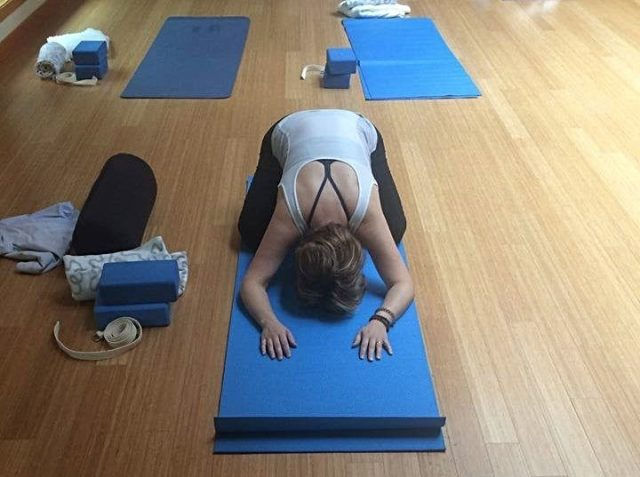6 Reasons You Should be Doing Yin Yoga
- Laura Taylor
- Apr 20, 2017
- 4 min read
Yin Yoga is one of the lesser-known styles of yoga, but since it is one of my favourite styles to teach, I often have people asking, “What is Yin Yoga?” and, “How is it different from Restorative Yoga?”
But Yin Yoga is gaining popularity. It was even featured in a recent episode of Grace & Frankie on Netflix (Season 3, Episode 11, at 4:42.
If you still need coaxing, read on.
1. ANYONE can do Yin Yoga.
I believe and preach that anyone can do yoga, but if I could amplify that statement, it would be to say that anyone really can do Yin Yoga.
Yin Yoga meets you where you are. The practice uses props like blankets, blocks, and bolsters to support the poses, and the more props the better! In this way, no level of flexibility is required. You make your way into a pose and prop yourself up as necessary.
No level of strength is required. Usually, an entire Yin Yoga practice is done lying down and sitting. In fact, the entire point of the practice is to not use your muscles – Isn’t that fun news?! (Disclaimer: There is a Yin Yoga counter pose called Crocodile, which strongly resembles forearm plank…but I promise it’s good for you.)

Prenatal Supported Butterfly – Yin Yoga
2. Yin Yoga can improve your flexibility like nothing else.
Hatha Yoga and traditional stretching target our Yang tissues (our muscles). This is awesome, as our muscles often need to be released. But Yin Yoga targets our Yin tissues; our connective tissue and fascia, our joints and ligaments.
As an example, if you get ‘frozen shoulder’ (adhesive capsulitis), it is more the joint capsule, and not the muscles, that has to be released to regain shoulder mobility.
This Yin tissue called fascia connects everything in our bodies: blood vessels to organs, muscles to skin, etc. If we don’t move a joint through its full range of motion frequently enough, fascial adhesions may form, causing decreased range of motion, dysfunction, pain, and even organ dysfunction.

Andrea doing Child’s Pose in a Yin Yoga Class in Whistler
3. Yin Yoga teaches profound body awareness.
Deliberate exercise and mindful yoga both teach body awareness, with practice. But in Yin Yoga, we have time on our side. Since we spend at least two, and sometimes as long as 20 minutes, in each posture,
Yinsters have time to feel.
In Yin Yoga, we move slowly into each pose, without forcing or pushing. This encourages us to really feel the resistance we are bumping into and notice exactly where we are feeling it. This mindfulness gives us concrete insight into what is going on in our bodies. A single Yin Yoga pose can affect several joints, but you will feel sensation in the place of most resistance – this gives you information about your ‘fascial tight spots.’ More often than not, you will feel a posture more on one side than the other side. This is perfectly normal, as none of us are symmetrical, but it can give valuable information about what’s going on between our right and left sides.
After practicing Yin Yoga for some time, you will learn the arc of feelings that often occur in a Yin Yoga pose; the posture may begin with discomfort, the discomfort will either intensify, decrease, or go away completely.
4. Yin Yoga gently forces you to self-love.

Yin Yoga is a careful dance between too little and too much, or what my Yin Yoga teacher, Bernie Clark, calls “The Goldilocks Position.”
The Goldilocks Position is not too cold, and not too hot, but just right. In a Yin Yoga posture, we are looking for that Goldilocks position, where you feel some sensation – it’s not too little – but you don’t feel so much sensation that you experience pain – it’s not too much. It’s just right. Constantly being aware of this balance forces us to be mindful, and stay present, which is my next reason to do Yin Yoga…
5. Yin Yoga gently forces you to still your monkey mind.
Arguably, the most challenging aspect of Yin Yoga is the stillness of the mind, and not of the body.
In our society, we are conditioned to believe that business and constant activity are of greater value than rest and stillness. For years, you may have told yourself a story that to relax or to be still is to be lazy. But your body doesn’t believe that story, which is how we end up with anxiety, pain, sleeplessness, etc. When first starting Yin Yoga, (or any mindful yoga practice) it will be very challenging to be still without mentally going through your to-do list and have your monkey mind take you away. Over time, it will become easier, and you will notice longer periods of stillness between thoughts. This is why yoga is called a practice.

Students in a Yin Yoga Straddle at Thrive Movement Studio
6. It feels #$%*ing good.
If for no other reason, do Yin Yoga because it will make you feel daaamn good.
In my personal opinion, I usually walk away from my Yin Yoga practice feeling even better than I do after my Flow or Hatha yoga practice.
Give it a try – because Yin is in.






Comments